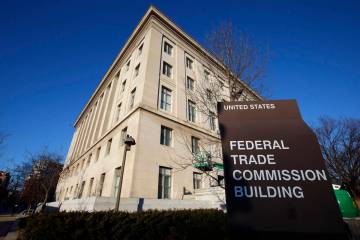Molycorp mine near Primm set for revival
MOUNTAIN PASS, Calif. -- With the ignition of a few blasting caps this week, the Molycorp rare-earth mine will jolt back to life after hibernating for more than eight years.
The blast will be just a test, but it will open the way to full-fledged rock extraction next year and signal the start of perhaps the largest construction project within 100 miles of Las Vegas. Through July 2012, Molycorp plans to spend $532 million to clear away almost all of the antiquated processing machinery now on the site and replace it with a plant designed to lower operating costs and water use.
The construction will employ an average 700 people a day, many of them expected to commute daily from Las Vegas. All but three of the 140 permanent employees make the drive on Interstate 15.
Millions of people drive by the mine, which is visible from the highway, every year. But very few people know what it is.
The revival of what was once the world's largest rare-earth mine comes as a long-obscure mining industry niche gains a higher profile. China now holds a monopoly on the production of rare earths, a key ingredient in high-tech products ranging from iPads to hybrid cars to laser-guided bombs, and funnels much of it to its domestic manufacturers. The United States has not produced any rare earths since Molycorp halted mining in 2002 and it has no factories that make products including rare earths.
Molycorp Chief Executive Officer Mark Smith and other company executives have assiduously lobbied legislators and agencies in Washington, D.C., for two years to raise the issue as they seek $280 million in federal government financing for the mine renovation.
"We are very, very committed to creating a mines-to-magnets rare earths supply chain on U.S. soil," he said during a media tour attended by journalists representing outlets across the United States, Europe and Japan.
Magnets enter the equation because some of the 17 minerals classified as rare earths, notably neodymium, greatly improve their performance. Molycorp's application for a long-term, low-interest $280 million loan from the U.S. Department of Energy is based on the critical role magnets play in windmills that generate electricity.
The company calculates that a shortage of rare earths will soon emerge as worldwide demand rises and China, which controls 97 percent of the supply, tightens exports quotas. This comes even though most products need only a dusting of rare earths weighing a few grams at the most.
Analyst ratings have helped make Molycorp one of the year's hot stocks. Benzinga.com reported Thursday, for example, that the New York investment bank Dahlman Rose & Co. rates Molycorp stock "buy." After going public at $14 a share on Aug. 3, Molycorp stock, which trades on the New York Stock Exchange under the ticker MCP, has soared as high as $40.90. It closed at $38.26 on Friday.
Reports that China had temporarily halted exports to Japan over a territorial dispute involving a fishing boat and that China had decided to tighten export quotas for the coming year fueled the price rise.
"A lot of elected officials and agencies now understand we need to do something about it," Smith said.
The recent sharp price jumps have sparked interest in rare-earth mining around the world. A mine in Mount Weld, Australia, is the closest to coming on line.
Despite the name, industry experts agree that rare earth elements are very common, but exist in commercially viable concentrations only in a few places.
Also, engineers have started looking for ways to reduce their companies' dependence on rare earths. Earlier this month, for example, Japanese industrial giant Hitachi announced a program to recycle rare earths found in products such as air conditioner compressors.
That has led some analysts to conclude that the current rare earth market resembles a bubble. Despite short-term tightness, Ed Dolan, a visiting professor at the Stockholm School of Economics, wrote, "In the long run, all evidence points to much greater elasticity of both supply and demand."
Reports of a leaked study by the Pentagon on the importance of rare earths in weapons manufacturing said any supply crunch would ease by 2014 and would not constitute a national security threat.
Smith noted that the reports were based on a draft and said company executives have been in contact with defense officials to change the conclusions.
"If you were in the military, would you admit this was a national security problem?" Smith said.
The mine, at an elevation of about 4,500 feet, the crest of the pass through the mountains south of Primm, opened in 1952. For about half of its existence, the mine produced mainly europium, an element that creates the red in color televisions.
Operations halted in 2002 in the face of low-priced competition from China and four years after a spill of toxic wastewater in the desert between Primm and the mine. Through a separate deal, ownership passed to oil giant Chevron, which did not want to remain in the mining business.
During the mine's life, plant manager Rocky Smith said, digging covered 55 acres and went 400 feet deep, creating a hole with terraced walls. Over 30 years, he said, the mine could go another 1,000 feet deeper and another 55 acres of surface.
To finance the mine project, which obtained its final permit Monday , Molycorp raised $387.6 million through the stock offering. It also announced a $130 million debt and equity investment by Sumitomo Corp. in return for a supply of rare earths spanning seven years.
The application for the $280 million government loan was rejected last year, a company spokesman said, because the Department of Energy did not want to finance mining. Since then, Molycorp retooled the paperwork to emphasize that it will try to move into advanced ore processing and even manufactured products such as industrial magnets.
During the nine months ended Sept. 30, Molycorp recorded revenues of $13.2 million from processing rocks mined before the shutdown. This produced a net loss of $41.3 million, half of it coming from stock-based compensations that were part of the public offering.
In two years, when it's fully operational, the mine will 19,000 metric tons of rare earths a year compared with 2,000 now. If sales support it, the plant could be expanded to a capacity of 40,000 tons.
Although the mine is Molycorp's only property, Smith has kept the headquarters in Greenwood Village, Colo., to remain close to the concentration of natural resource companies in nearby Denver.
Contact reporter Tim O'Reiley at
toreiley@reviewjournal.com or 702-387-5290.






























